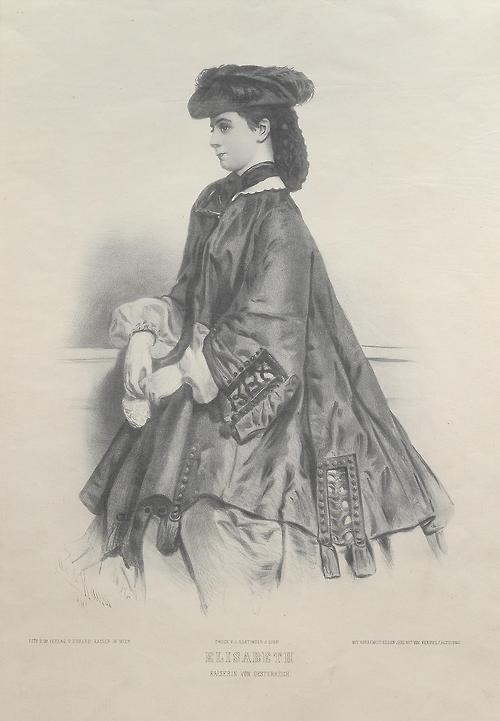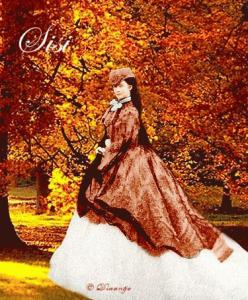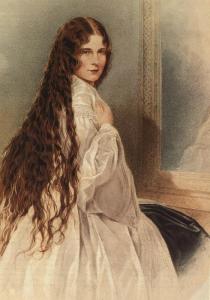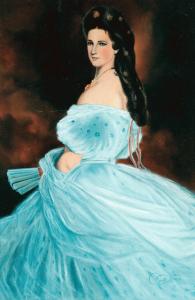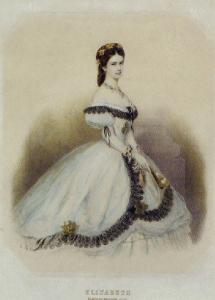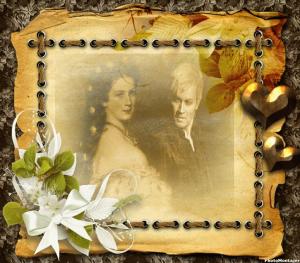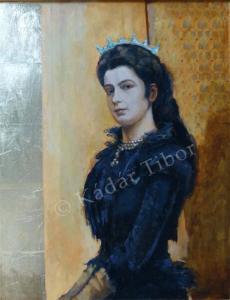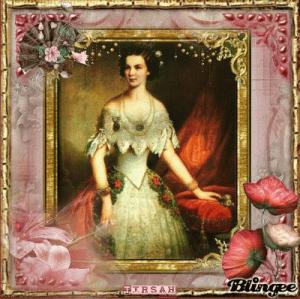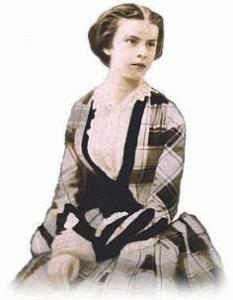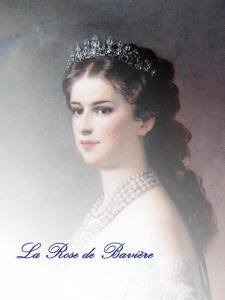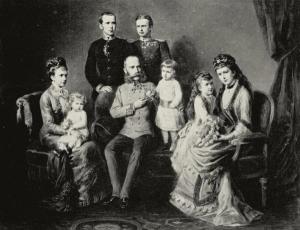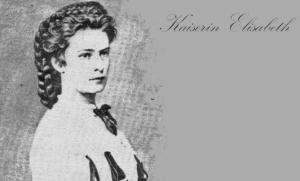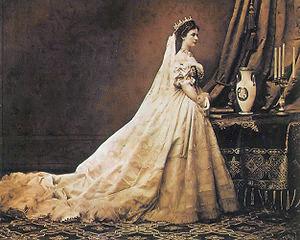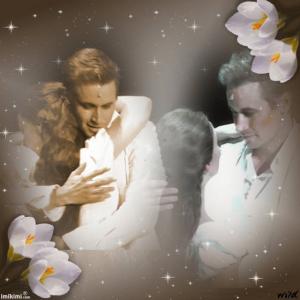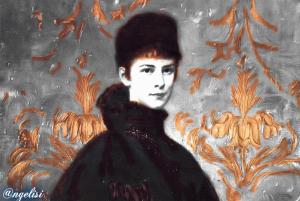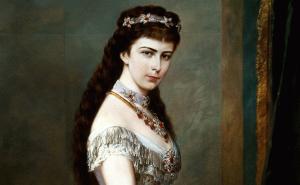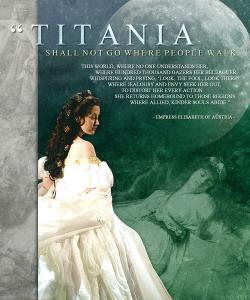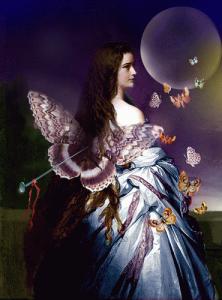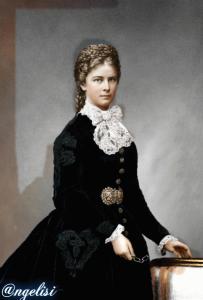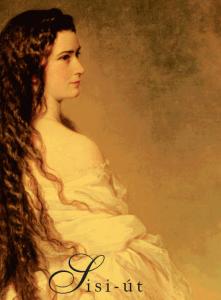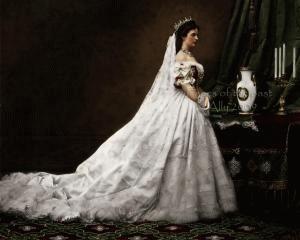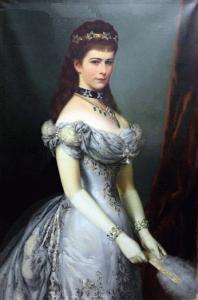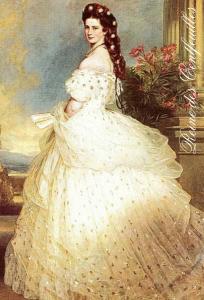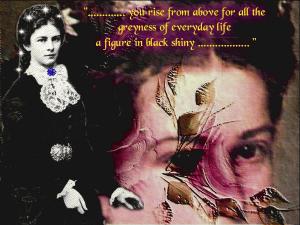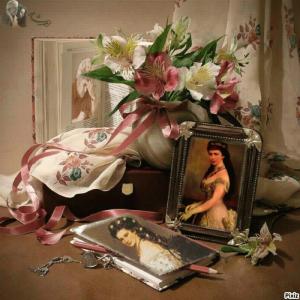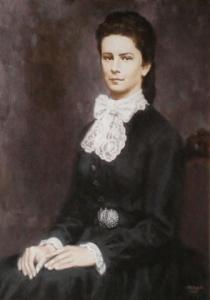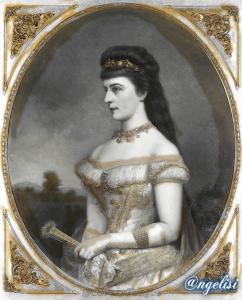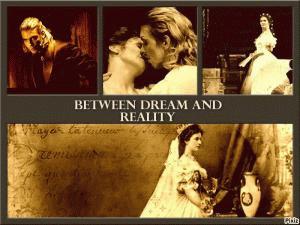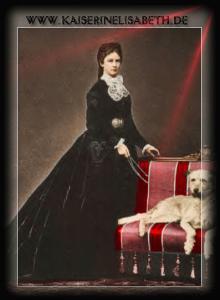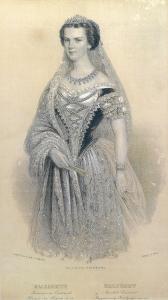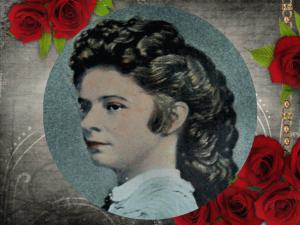
Elisabeth, Empress of Austria & Queen of Hungary...................Beautiful & Mad?
by Claudia Terrones
Elisabeth, Empress of Austria and Queen of Hungary, has been often maligned and compared to that other very famous royal woman of our times, Diana, Princess of Wales. Although they shared similar obsessions with their figures and have both been described as young, naïve women who didn't know what they were getting into when they married, there is more to Elisabeth than the two words usually associated with her: Beautiful and Mad.
Born on Christmas Eve 1837, Elisabeth was a Wittelsbach, and a Duchess in Bavaria. Her parents, Maximilian and Ludovika, allowed her much freedom during her childhood, which in hindsight might be considered a mistake, but since it was her older sister Helene (known as Nene) who was supposed to marry well, dynastically speaking, Elisabeth was allowed to do as she pleased.
In 1853, when Elisabeth was sixteen, she accompanied her mother and Helene to Bad Ischl, where they were to meet their cousin, the 23-year-old Emperor Franz Josef. Helene was the intended bride, and indeed, Franz Josef wasn't supposed to even see much of Elisabeth. One account has an impetuous Elisabeth bursting into the "grown up" dining room where Helene and Ludovika were dining with Franz Josef. She realized the enormity of her faux pas, but Franz Josef had seen her and been instantly smitten. Eight months later, on April 24, 1854, Elisabeth and Franz Josef were married in the St. Augustine Church of Vienna, with festivities lasting over a week. Despite the lengthy preparations and teachings Elisabeth had received for her new life as Empress of Austria, nothing could prepare her for the rigidity of the court - or the disapproval of her mother-in-law, the formidable Archduchess Sophie (Ludovika's sister and Elisabeth's aunt), who had wanted the more even tempered Helene as wife for her son.
Sophie found much wrong with the still childish Elisabeth, who began to feel increasingly caged in by the court etiquette. Despite Elisabeth's growing unhappiness, Franz Josef remained unwavering in his love and devotion for his wife, and the couple had four children: Sophie (named after you-know-who), Gisela, Rudolf, and Elisabeth's favorite, Marie Valerie.
Elisabeth began to travel, each time farther and farther away from Austria, seeking any form of escape. Possenhofen, the home of her childhood, Madeira, Corfu, were all places where Elisabeth sought to regain some of the independence of her younger years. Of all her children, Marie Valerie was the only one Elisabeth felt close to, but it would be Rudolf who would bring enormous grief into her life.
Much to Archduchess Sophie's anger, Elisabeth took up the cause of the Hungarian people and was partly due to her influence that the Hungarian Compromise was achieved. Sophie, of course, saw it as Franz Josef being unduly guided by his wife. In Hungary, however, Elisabeth became much loved, and the couple was crowned as King and Queen of Hungary on June 8, 1867.
In 1881, Rudolf had married Princess Stephanie of Belgium, but the marriage was an unhappy one, and his only solace was his lover, the very young Countess Mary Vetsera. On January 30, 1889, a despairing Rudolf shot Mary dead and then killed himself, at his hunting lodge in Mayerling, a tragedy from which Elisabeth never really recovered. "Entrusting" her husband to an actress, Katharina Schratt, Elisabeth began to travel even more around Europe, usually under the name "Countess Hohenembs." It would be on the shores of Lake Geneva where she would find death, at the hand of Luigi Luccheni, an Italian anarchist who had found out about Elisabeth's visit to Geneva via a newspaper. Luccheni stabbed the Empress on September 10, 1898, as she walked toward the waiting boat along with a companion. The wound was so tiny that the blood leaked out very slowly and at first, Elisabeth did not realize the extent of her injury, but then she collapsed on the boat and soon after, died. Luccheni had no real reason to kill Elisabeth, he'd meant to kill the Prince of Orleans, who was not in Geneva, so Elisabeth was at the wrong place at the wrong time. While serving a life sentence, Luccheni hanged himself.
What remains of Elisabeth of Austria's life? Most famously, these magnificent portraits by Franz Xavier Winterhalter.
The portrait on the left is perhaps the most famous of all of Elisabeth's portraits, in full court dress and with diamond stars in her hair. It is even more magnificent up close. Franz Josef's favorite, however, was the portrait on the right, a more informal picture of his beloved wife with her hair down, the portrait he kept in his study long after she died.
Was Elisabeth beautiful and mad, then? Beautiful she was, although photographs show an average-looking woman, but all who met her commented on just how incredibly beautiful she was. She was also very vain. Her hair was very long, and the maid who combed it every day had to go through great pains so Elisabeth wouldn't see the hairs that inevitably fell out. She dieted constantly and exercised strenuously, be it horseback riding or using weights and her exercise apparatus.
Was Elisabeth mad? While she undoubtedly had some problems, Elisabeth wasn't crazy. She was merely too young and unprepared for what was coming. The Wittelsbachs were reputed to have a melancholy streak in them, and add this to being transplanted from an idyllic childhood to a stern household where she was nothing more than a continuing disappointment to her mother in law and the court, and Elisabeth's wish to escape was understandable.
Vain and immature, glorious and incandescent, Elisabeth of Austria remains the stuff of legends. A visit to the Kaisergruft (the Imperial Crypt) in Vienna will lead you to Sissi's grave, usually covered with flowers. Postcard racks everywhere bear cards with her image, and the musical based on her life was a sellout. The most famous Sissi movies, a trilogy, had actress Romy Schneider in the title role, and were a very romanticized account of Elisabeth's life, a life sadly spent in search of happiness.
From site : http://www.likesbooks.com/sissi.html
Paper doll's Sisi
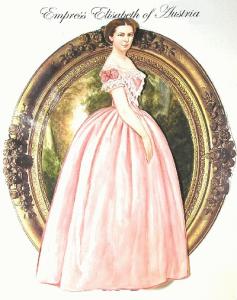
Sisi – Empress Elisabeth
Sisi was born on Christmas Eve in the year 1837 in Munich. During her childhood Sisi spent her summers together with her seven siblings at the small Possenhofen Castle, an open, rural area of Lake Starnberg. Her parents, Duke Max of Bavaria and Ludovika, had no official obligations at the Royal Court. So they left their children to play, romp and horse-ride in an easy-going fashion. At the age of 9, Sisi looked more like a tanned country child than a princess.
Ludovika, Sisi’s mother, was the daughter of the Bavarian King Maximilian I from his second marriage with Karolina von Baden. Contrary to her three sisters, she did not marry into a Royal family, but into a branch of the house of Wittelsbach. That her husband, and thus the line of Birkenfeld-Gelnhausen, was granted the title “Herzog in Bayern” (Duke in Bavaria), was only a small consolation for the disappointed Ludovika. After the wedding on 9 September 1828, marital problems arose, which could have been spotted prior to the wedding. Max was a typical Wittelsbacher and therefore freedom-loving, eccentric and unreliable, albeit charming. He spent a lot of time travelling, constantly on the run from everything that looked remotely like official duties. Ludovika, on the other hand, devoted herself dutifully and actively to her children, although she started late to teach them discipline and introduce them to aristocratic life. The big chance for the ambitious mother came when Sisi’s eldest sister, Helene, was taken into consideration as wife to the Emperor of Austria. While Max did not care for such pandering, Ludovika was ultimately trying to get near the crown by this way.
Ludovika and her sister, Sophie, mother to the Austrian Emperor Franz Joseph, chose Helene as bride to the young monarch. During the summer of 1853 the engagement should have taken place in Bad Ischl, but Franz Joseph thwarted the plans of the two mothers. Instead of Helene he fell in love at first sight with the 15-year-old Sisi, who only came into Salzkammergut to accompany her mother and sister. Their engagement was announced the very next day.
In April 1854 the magnificent wedding took place in the Wiener Augustinerkirche (Augustinian’s Church). At the beginning of their marriage, Sisi tried her hardest to live up to expectations , although she hated the ceremonial of the Wiener Hofburg and the strict regiment of her mother-in-law, Sophie. Although Sisi’s beauty and her naturalness were very popular with her people, Sophie did her best to transform the freedom-loving child into a disciplined empress. Sisi became melancholy. She found a little consolation with her very busy husband, who was her only foothold during her early time in Vienna. In 1858 Sisi fulfilled her most important duty as Empress: after two daughters, Sophie and Gisela, she gave birth to the longed-for Crown Prince Rudolf. All three children were taken from the supervision of her mother and given into the care of Archduchess Sophie, who wanted to give them an adequate educational background. But Sisi’s relationship with her mother-in-law thereby deteriorated noticeably. Amidst the tumultuous times of the revolution in 1848, the 18-year-old Franz Joseph ascended the Austrian Imperial Throne. This came about at the hands of his advisors and his mother, whose cold stiffness he had inherited. With a sense of duty and dogmatism bordering on cruelty, he reigned over Austria until 1916. Although he was very affectionate towards his wife, she suffered her whole life from his arrogant and boring character and his negligence of her in spite of his kindness. His cool confessions of love were often mixed with criticism. His womanising prompted Sisi to escape from Vienna. Only in later years was she able to bring more understanding towards her reserved and lonely husband. Archduchess Sophie, Sisi’s mother-in-law, was Ludovika’s older sister and like her a daughter of the Bavarian King Maximilian I. She was a woman of strong will and she forced the coronation of her son Franz Joseph after the abdication of Emperor Ferdinand I. Her weak-minded husband, Franz Karl, the actual heir to the throne, was passed over, just as she disclaimed the crown herself. Known as “the only man at court”, it was Sophie who ruled, through Franz Joseph, by words and deeds over Austria’s politics during the early years of his reign. She led the regiment into the Wiener Hofburg and strictly supervised the compliance to etiquette and the Spanish Court Ceremonial (“Spanisches Hofzeremoniell”). Sophie’s rigorous attitude towards the unwanted daughter-in-law, Sisi, originated in her own roots in this world of court protocol, which Sisi liked to mock so much. The final split between Sisi and Vienna came in 1860, when stories of certain relationships of Franz Joseph emerged. After Sophie, Sisi now also felt betrayed by her husband. On top of that she suffered from a strange illness, that the doctors at court discreetly called tuberculosis (“Lungenschwindsucht”), although the symptoms on the whole suggested a venereal disease. Disappointed by Franz Joseph, Sisi fled from Vienna and began to travel restlessly. During the next two years Madeira, Venice and Corfu became her preferred domiciles. And in later years she returned to Vienna infrequently. The insecure young Empress became a self-confident, mature woman. Travelling became her purpose in life. “If I arrived at a place and knew that I could never leave it again, the whole stay would become hell despite being paradise”, she confided to her Greek teacher years after her first escape. The Hungarians had always been a thorn in the side of the Austrian multinational state. In vain they fought for their freedom in 1848. Sisi loved Hungary, partly a protest against Sophie, who detested all Hungarians, but also because she felt close to the language and the people of that country. The year 1866 saw Austria plunge into a severe crisis, which threatened to break Austria from many sides. But Sisi’s commitment to an Austrian-Hungarian settlement on the basis of special rights and freedoms for Hungary released the tension between Vienna and Budapest. The Habsburg Empire was divided into two equally authoritative parts.
A Dual Monarchy emerged, with Vienna and Budapest as equal capitals. In 1867 Franz Joseph was crowned King of Hungary – Sisi’s biggest political triumph. Ten months later Sisi’s youngest daughter, Marie Valerie, was born. She was called, affectionately, the “Hungarian child” and was raised in the Hungarian language beloved by Sisi. She was always closer to her mother than those children raised by Sophie. Despite her commitment to Hungary, at the bottom of her heart Sisi was not a political person. Instead she counted on the power of her beauty, for which she earned world-wide admiration and adoration. At a height of 172cm she only weighed 50kg and constricted her already slender hips to 65cm. Her pride and joy was her heel-length hair, which needed care for hours on end every day. She once called herself the “slave of my hair”. To keep this beauty, Sisi kept rigorous diets and took exercise excessively – she practiced horse-riding, gymnastics and hiking. Her beauty provided her with fame, but in later years physical weakness and hunger oedema followed. Horse-riding was not only a way for Sisi to exercise, train her body and to sustain her figure, it also was a means of self-projection. Ambitiously, Sisi exercised many hours a day, not only to be the most beautiful monarch in the world, but also to be the best horse-rider and to surpass the only aristocratic rival on horseback, Empress Eugénie of France.
Envied by many, the Empress of Austria could not escape the strokes of fate that accompanied her life. In 1857 her first daughter, Sophie, died at the age of only two years. Ten years later, her brother-in-law, Emperor Maximilian I. of Mexico, was shot by anti-monarchy insurgents in his own country. His wife, Charlotte, went insane, and spent the last fifty years of her life suffering from mental illnesses at Miramare Castle, in uninhabited royal houses and in psychiatric clinics. One of Sisi’s closest friends, King Ludwig II. of Bavaria, was declared mentally ill as well and was locked away. After a little while he drowned in unexplained circumstances in Lake Starnberg. When Sisi’s son, Rudolf, committed suicide in Mayerling with his loved one, Mary Vetsera, in 1889, Sisi never recovered from the blow. Increasingly growing lonely, she experienced the death of her sister, Sophie, who died in 1897 during a fire at a charity bazaar in Paris. Over the years, on top of the numerous cases of death in Sisi’s family, there were her own thoughts of suicide, acted out in poems, but never put into action. When anarchist Luigi Lucheni thrust a pointed file into the heart of the Empress of Austria in Geneva on 10 September 1898, he encountered a woman disappointed with life. Destiny had found her eventually.
"She delivered her woeful imagery of loneliness to posterity, for which she used the term “future-spirits”
(“Zukunfts-Seelen”):
“I wander lonely in this world,
Delight and life long time averted,
No confidant to share my inner self,
A matching soul never revealed.”
(Sisi, The Poetic Diary)
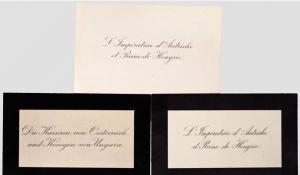
Empress Elisabeth of Austria - three business cards
Two tickets to the white end with the French word "L'Imperatrice d'Autriche et Reine de Ungarn", a black border card "The Empress of Austria and Queen of Hungary," the third ticket also outlined in black, but again with the French text. The Empress and the Emperor had different types of business cards, so the cards were offered mainly here to visit the official occasions sovereign or other use. Listings of black probably from the time of death of Rudolf in 1889/90
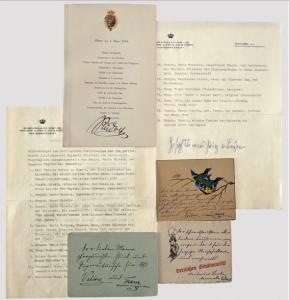
Personal album photo of Kaiserin Elisabeth 1880
34 large photo Cabinet Photos (17 x 11 cm) . In dark brown leather album with applied gilt and silver ornament plate with the crowned monogram of the Empress "E". Enclosed an explanatory letter from the Royal Bavarian Prince Joseph Clemens of Bavaria , where he observes the following: Notes on this family album from the Personal . Possession IKKMajestät Empress Elisabeth of Austria . Originally compiled by Ehzgin . Marie Valerie , the youngest daughter of the Empress . 1st Duke Karl Theodor in Bavaria, the favorite brother of the empress, with his second wife, Princess Maria Josepha of Portugal, at a masked ball in 1883. 2 Ehzgin . Gisela , eldest daughter of the Empress , with her husband Prince Leopold of Bavaria, Masked Ball in 1883. 3 Ehzgin . Marie Valerie , Masked Ball in 1883. 4 Ehzgin . Marie Valerie . 5 Ehzgin . Marie Valerie and her children , handwritten dedication to the Empress " With all my heart you hugs Mummy Dearest Valerie and their babies ." 6 Ehzgin . Marie Valerie and her husband Ehzg . Franz Salvator with her two oldest children Carl Franz Salvator and Elizabeth. With dedication " Congratulations Valerie and Franz" . This is followed by Marie Valerie with daughter Elizabeth, her son Hubert Salvator , Emperor Franz Joseph with his grandchildren Elizabeth, Franz Salvator and Hubert Salvator , Stephanie of Belgium ( signature) and her husband Crown Prince Rudolf , her daughter Elisabeth alone (2x) and with Stephanie , Stephanie ( 2x) , Princess Maria ( signature) , the Belgian royal couple in individual portraits , Louise of Belgium (3x) , Prince Leopold of Coburg ( handwritten dedication) , Princess Clementine , Ferdinand Philip of Coburg, Ehzg . Karl Ludwig ( brother of the Austrian emperor ) surrounded by his family , Ehzgin . Annunziata with their children , Ehzgin . Maria Theresa ( signature) Ehzgin . Margaretha Sophia, Ehzg . Franz Ferdinand ( signature) Ehzg . Otto ( 2x with signature) , Ehzgin . Maria Josepha and Ehzgin . Gisela and Prince Leopold of Bavaria. Detailed , accompanying explanations of Prince Alfons . Dimensions of the album 27 x 24 cm. For this purpose, a diner menu March 4, 1878 with the signature of the Crown Prince Rudolph and three greeting the Ehzgin . Marie Valerie and Franz , one of them to the Empress " The love Mama heartiest congratulations and good wishes for 1893 - Valerie and Franz" .
Exceptional photo album owned by the Empress Elizabeth of Austria ( "Sisi" ) , probably a gift from her favorite daughter Marie Valerie .
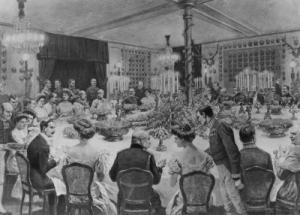
The eating habits of the Empress
Empress Elizabeth was terrified of gaining weight, although the Emperor and all the people around them were shocked by their thinness. At a height of 172 centimeters Sisi never weighed more than fifty pounds. Moreover, the Empress suffered again and again - even in the early years - to swelling (especially in the legs, ankles, face), which in turn increased their desire to meet the supposed obesity through extensive starvation. Empress Elisabeth gave way to the common meals from partly in order not with the family (or the official guests) meet - a fact which her mother, Archduchess Sophie could not understand.
By their irregular and unhealthy lifestyles Elizabeth was prone to stomach cramps and catarrh, which plagued her for days. In such cases, the Empress was the food or the wine of the blame for their ailment. She had problems with their digestive and suffered - despite their joy of movement - to constipation, which again led to unwanted "weight gain".
Phases in which the Empress ate with appetite, alternated with periods in which they were hungry for days or only liquid ate. Besides orange juice (Emperor Franz Joseph feared the acidity of the stomach), grape cures (Merano), meat juices and Karlovy Vary water milk and dairy products were the most popular foods of Empress Elisabeth. Already in 1867, there is evidence that the empress had prepared meat juice; daily was a calf Schlegel delivered to their room. For the production of the meat juice to let the Empress ducks presses from France get that from damage by JC Klinkosch or Berndorfer metal works were repaired or supplemented. Four of them have been preserved in the former Court Silver and Table Room. Accompanying them on their travels Hofköche and Hofzuckerbäcker had to be versed in the treatment of these specific products: "The cows are well - have enough milk so that Seitz both buttermilk, as well as butter makes of it, - this morning, we have very good pot pie had. "Because Elizabeth's passion for milk and dairy products and eggs had been so in 1895 in the Schönbrunn Kammermeierei for keeping cows and chickens.
In Vienna, the food problems of the Empress were because of her unsympathetic environment particularly large. When Elizabeth appeared at official dinners, they usually took only a little broth, a piece of white bread and some fruit. She rarely drank a glass of wine. My dessert was often small pieces of ice, was dripped onto the orange juice. In later times, after the death of Crown Prince Rudolf - she took part in festive meals very rare evenings they often drank only milk. In 1866 (the war against Prussia) wrote the Emperor Franz Joseph and his wife, the appetite of the political situation: "Sisi grown very thin and has suffered a lot with me." When traveling Empress Elisabeth tried again and again, not least because of official invitations from the way to go in order to escape her unbearable compulsion to eat. "Official" on the go, not just in Vienna or in part to one-set periods in which sis refused the food completely. Empress Elisabeth had a weakness that they underlay despite slimming efforts again and again: candy. The file inventory Lord High Steward of the Empress Elisabeth Wiener House, Court and State Archives, there are numerous accounts of Demel, Gerstner, Pischinger and Gerbeaud substantiate this preference. Even after she settled Corfu Forward specialties Cabos; Sisi moved by this company include often Andrássy biscuit. She developed a special fondness for the products Antom Rumpel Mayers. A native of Upper Austria confectioner had settled on the French Riviera, where Empress Elizabeth spent a lot of time. She regularly visited the shop and bought a lot in with him. They appointed Rumpelmayer even for k.u.k. Hofzuckerbäcker. The wife Rumpel Mayers was awarded by the Empress with a brooch name cipher. Rumpelmayer was not just confectioner, he offered in his establishment also food, sometimes the Empress took their meals with him. His businesses were in Cannes, Menton, Monte Carlo and Nice. The daughter Mayers ran a lumber store in Aixles-Bains, so that the Empress herself in Savoy to enjoy their pastry had estimated. Your favorite sweets were frozen, biscuits, pretzels, and crackers. Sometimes they also ordered cakes. Among the dishes, the Empress Elizabeth also estimated, were salted pastries such as cheese cakes, onion, and Schinkenkipferl. The later the child cook cooking for Archduchess Marie Valerie, Therese Teufl prepared, especially for the so prized by Elisabeth Violet Frozen. This is extreme even Emperor Franz Joseph as follows:. "The thought of violets with Frozen orange gave me almost Übligkeiten" Empress Elizabeth was also the enjoyment of Genois cake not (similar to biscuit) averse even had their own recipes for The Empress in her France stays allocated by the Sûreté security officials confirmed: ". Elle ... marquait une Predilection pour les friandises" Sisi's preference for fresh and pastries spoke rapidly around the representatives of baker or confectioner industry.
Dal sito: http://www.wien-vienna.at/sisi-essen.php
Elisabeth of Austria (Sissi): psychological analysis of the princess.
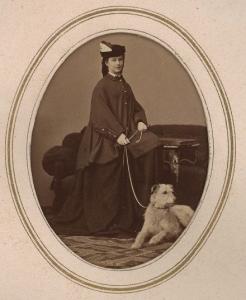
Elisabeth of Austria (Sissi) .............psychological analysis of the princess.
From People andCharacters> Elisabeth of Austria (Sissi)
Editorial
The story ofEmpress Elisabeth of Wittelsbach is very different from that of Princess Sissiwe have known in the film played by Romy Schneider "Princess Sissi"(1955) "the young Empress Sissi" (1956) and "The fate of anEmpress" (1957).
Born in BavariaPossenhofen-Christmas Eve of 1837 by Duke Maximilian and Duchess Ludovica ofBavaria, had seven brothers and she was the third child.
Her mother was thesister of Archduchess of Austria Sofia. His father, Maximilian, however, was avery original, liberal ideas. Preferred to teach their children a love ofnature, horses, walking in the mountains and animals, rather than thegenealogies of the imperial household. Elizabeth, called Sissi, then grew inthe midst of nature, developing a passion for the sport, not really unusual fora lady of his time and of his rank.
More than a sportreally should talk about simple physical movement, such as walking, swimming,etc. gallop. To give an example, in fact, Sissi did not like to play tennis,because the need to find a playmate to exercise made her feel anxious. He moveda lot, however, with great energy and passion lasted throughout his life. Whenarthritis prevented her from riding, began to take long walks in the woods onone occasion traveled 30 km using only seven hours. At sixty years old, shortlybefore his death, he learned to ride a bike. Not equal love felt for culture,nor the rules of court etiquette. But she liked to write poetry and appreciatedparticularly Homer.
In 1853, atsixteen, she met her cousin Franz Joseph, who was about to marry his sisterElena. When the future Emperor of Austria saw her, he immediately asked for herhand. The wedding took place on April 24, 1854, but the Empress of Austria andthe court never saw frowned on this marriage of the heir to the 'Duchess withhooves'. The Viennese aristocracy in fact made fun of her and her behavior,considered absolutely out of place nell'ingessatissimo environment court, sothat the sovereign did everything to try to quell the rebellious daughter, evenin his private life. All this intensified the anxiety of the young Sissi andcracked the relationships between the couple, which until then had been quitegood.
Sissi was one themost beautiful in Europe. His hair, of which he was proud, reached to thefloor: their care the occupied about three hours a day. But Sissi not only tookcare of his hair, he painstakingly took care of the body and of its line. Inparticular, he wanted to keep his body weight 50 kg (was 1 meter high and 72cm) and have a waist of 47 inches. To achieve this purpose is required ofstarvation diets and the continuous movement. No one at that time could nottell her who suffered from anorexia, but it was so. In order not to lose theline would not even want to have children, and instead they had four, mostly inthe care of the mother-in-law: Sofia, who died at age two, Gisela, Rudolf andValeria, his favorite daughter, the only loved by Sissi considered as an onlychild.
Pregnancies andsubsequent diets for weight-regain form (according to his standard), increasedhis irritability and insomnia caused. Also followed the natural diets inventedby herself, such as raw meat, raw beef blood, a lot of milk. Not to forget thefresh milk, during his travels he brought with him the cows and goats. Alsodrank kefir, a drink due to the fermentation of certain bacteria in the milkwas well known in Russia but not in Central Europe.
The disagreementswith the mother-in-law and the court took her to get away from Vienna for twoyears, during which time he traveled extensively and lived in Madeira, Corfuand in Bavaria. He then returned to Vienna, decided to take a public role. Thenbecame interested in the cause of Hungary.
Hungary was thethorn in the side of the Empire and the Hungarian revolutionaries were seen asthe wool over the eyes of Franz Joseph and his mother Sofia. Nothing better toElizabeth, to gain a role of public importance. He became interested in thecause so that he could carry out a treaty to be crowned in 1867, Queen ofHungary. This town loved literature, music, people. Even his last child wasborn in this country and for this he called 'the daughter Hungarian'. The Magyarpeople was thrilled by his queen, to whom he dedicated countless streets,squares and statues, but soon after, reached the goal he had set, the interestof Sissi for this cause vanished.
Even as a motherand mother-in-law Elizabeth did not have the maximum satisfaction. His sonRudolf, the heir to the throne, he married Stephanie, Princess of Belgium(known as Sissi 'insignificant bifolca'). The beginning of the marriage washappy, was born a daughter, Elizabeth, but then deteriorated. Rodolfo demandedthe annulment of the marriage to the Pope, but did not get it and it began tohate his father, a devout Catholic, who had signed a concordat with the Church,which was recognized the authority of the ecclesiastical courts. Stefania fellin love with a Polish count and Rodolfo, who suffers from nerves, syphilis,began to fight depression with stronger doses of morphine. Fragile and unhappy,was found dead with his mistress, Maria Vetsera, in the castle of Mayerling.There was talk of a double suicide. This death was not only the failure of theprivate life of the imperial family, but also a serious problem from the pointof dynasty. There being no other sons fact, the throne would pass to thebrother of Franz Joseph, Charles Louis, who died for typhoid fever contractedduring a pilgrimage to the holy land. (For the record, he was heir to thethrone, Franz Ferdinand, a man who hated Hungarians, Jews and Italians.Francesco.Ferdinando was assassinated in 1914 and his wife in Sarajevo, Serbia.This episode led Austria to declare war on Serbia, defense which steppedforward to Russia and thus triggered the First World War. But that was manyyears after the death of Sissi ...).
Returning to theEmpress, in 1870 he decided to retire from public life, leaving her husband inthe arms of her lover historic Katharina Schratt. So it was that one day,walking with some friends to Geneva, was killed by the anarchist Luigi ItalianLuccheni with a punch. It was September 10, 1898 and Sissi was 60 years old.For many years after the death of Sissi, has told his story in films and books,until one day there came yet another princess, beautiful rich and unhappy ...Diana Spencer. And the sad tale of the Princess went with her.
Psicolinea.it ©2001-2011
From http://www.psicolinea.it/personaggi/elisabetta-daustria-sissi/
The most face of Sisi ( from Europeana site )
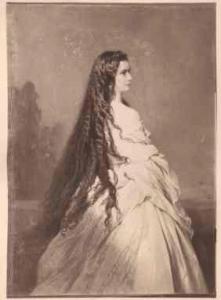
The beauty of Sissi . The " flirts " Empress
Pretty sure it was the princess Sissi , just observe it in the many portraits in which it is represented : the perfect oval face , big eyes and deep , regular lips , gorgeous long hair on a slender body and slim , and if you add the innate grace , the posture naturally elegant and sweet and delicate femininity that embodied , it is not difficult to understand the reasons that have made it a myth from the point of view of aesthetics .
Yet the same undeniable beauty that made her famous , he was also a tremendous worry for Elisabeth of Bavaria , all too aware of his charm and willingness to sacrifice hard to bear in order to keep it intact over time.
The body of Sissi was very different from that characteristic of the women of the time, usually soft and curvy , taller than one meter and seventy centimeters per 50 pounds of weight scarce , represented a type female nearest to the canons of today than to those nineteenth century , although shaken up by unanimous appreciation of the male gender .
The Empress was always surrounded by a crowd of admirers, of whom accepted the flattery never reject them openly and often with which instaurava a game of mutual seduction made of looks, gestures and words , but no concrete actions, ever since he came to betray his Franz .
Sissi a woman who regularly flirted with men , then?
Although it may seem strange, especially if the image that has made her roughly corresponds to that of the famous movies of the beautiful Romy Schneider in the 50s and 60s , it is, but it was only a competition with itself, the best way to test their ability to confirm the seductive power that was able to exercise over men, nothing more.
This singular behavior depended largely on the overall psychological state of the woman, constitutionally fragile and has worsened over the years : unstable and insecure, forever in search of new ideas and dissatisfied with life at court , Sissi was not in the consciousness of their common physical beauty the fastest way to gain confidence in their abilities.
The care of the body and the search for the perfect shape turned to the sovereign of Austria obsession ate very little for fear of gaining weight , underwent a strenuous gym sessions and grueling sporting performance , especially riding his lifelong passion .
But as time passes relentlessly for everyone, including principles , and life experiences , especially the painful ones , leave a mark , just 56 years, the Empress decided not to portray more of a painter and the idea of not being more than that of the first was unbearable.
From site: http://cultura.notizie.it/la-bellezza-di-sissi-i-flirts-dellimperatrice/
The Sisi from Europeana site
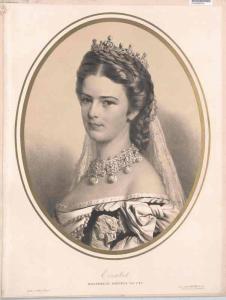
Empress Sisi ... not the myth but the reality
It 'a really long time that I want to dedicate a post to this wonderful woman, and is as much time as we work on. On the web, and not only that, there are a myriad of conflicting information and agree on the famous Empress Sissi. So it took a lot of work to select and summarize all the info I could find. I hope you'll be all inclusive and if I forget something (It probably will) or have any other questions about it please write a comment below the post non-anonymous and I'll be happy to expand the topic. Meanwhile there is to distinguish the film Sissi and the real Elizabeth. I decided to just take care of the real Elizabeth, not only because dedicating the post to Elizabeth is right to talk about her and not the myth that has been created on his person, but also because the Sissi films and cartoons is already known too well by all of us. Less known is the REAL Sissi instead. Elisabetta Amalia Eugenia (known as Sissi) was born December 24, 1837 in Monaco of Bavaria, the fourth of ten children of Duke Maximilian Joseph (aka Max) and Ludovica of Wittelsbach, daughter of King Maximilian I of Bavaria. Both his parents were of noble family, but his mother belonged to the branch of the royal family. Elizabeth spent her childhood in Monaco serenely in the family palace, while the summer months were spent in Possenhofen Castle, a residence in which the young duchess, nature lover, was very close. As a sensitive soul, she was raised in a simple, accustomed to neglect the formalisms and turn their attention to those who had less chance of her: the poor and sick. The sensitivity of Sissi mood was positive for a period of his life because it led her to be different from the others belonging to noble families, not at all snobbish and aristocratic but attentive to the needs and misfortunes of others as well as sensitive to the charm of nature and animals , but paved the way for emotional fragility that characterized the rest of his life. Even as a child an impassioned soul, lively, impetuous. He was cheerful, jovial, loved the company of the brothers but every so often he felt the need to isolate. At the age of 14, like all teenagers, she too fell in love, but unfortunately the squire salaried his father, certainly not a good match for her. The young man was removed and sent elsewhere with another assignment. Once back in Monaco, in a short time he became ill and died. Elizabeth was devastated and went through a period of total closure in itself, during which employed his time writing poems for her love ended in tragedy. In that same period, the winter of 1853, negotiations were underway between the Duchess Ludovica (Sissi's mother) and her sister, the Archduchess Sofia, in order to marry the daughter of the first and Sissi's sister, Helen, his son the second, the Emperor Franz Joseph I of Austria. The choice fell on the Archduchess Sofia Elena (called Nene) after two failed projects with Prussian and Saxon princesses, because he wanted to settle next to a German child, strengthening the role of Austria in German. Although Elena was not a direct member of a royal family, was still a bond with Bavaria, one of Germany more loyal to Austria, and was obviously a noble family even closely related to the real one. The two sisters decided to bring together the two brides and grooms Ischl, the summer residence of the emperor, during the birthday party of the latter with the idea to publicly announce their engagement on that occasion. Ludovica decided to take along Elizabeth, who initially wanted to leave willingly, hoping to wrest the melancholy in which she had sunk, and with the secret intention of combining her engagement to Charles Louis, younger brother of Francis Giuseppe.Così sister less would become Empress and the other would still become part of the royal family. The Duchess Ludovica and daughters arrived in Ischl August 16, 1853. In the afternoon there was a first meeting with the Archduchess Sophia, the son of Franz Joseph and Elisabeth of Prussia, another sister Ludovica and Sofia. Since that first meeting and formal, it was evident that Francis Joseph had not infatuated with Elena, but the youngest child and Elizabeth. The Archduchess Sophie wrote to his sister, Marie of Prussia, of his son and at this meeting: "She was radiant, and you know how his face lights up when he is happy about something. The dear child had no idea of the impression aroused in her by Franzi. Until the moment when the mother spoke to her openly, Sissi was just intimidated and frightened by people around him. " We can say that it was really love at first sight, especially for him. Elizabeth was unaware of anything, unaware of the rules of court and related formalisms, and appeared in his eyes as he was: spontaneous, innocent and bright even if a little regal Elena instead, all composed and careful to behave as you would expect from the chosen Empress, not wrought in him nothing more than the simple affection for a cousin. The day after Franz Joseph said to his mother that his choice had fallen on Elizabeth, despite the Archduchess Sophie prefer Helena. In the reception given that evening, the Emperor danced the cotillion with Elizabeth, a clear sign for all of his preference, but not for Sissi who did not understand. Even during the dinner on 18 August, birthday of Franz Joseph, Elizabeth was seated next to him. The next day Ludovica, on behalf of the emperor, he asked Elizabeth if she was determined to marry her cousin Franzi, and naturalmenten Elizabeth agrees, now also in love with her. Began negotiations with the Holy See to obtain the necessary papal dispensation, because that Elisabeth and Franz Joseph were first cousins. This close relationship, as usual for that time, was not considered, although several members of the Wittelsbach family had already shown their hereditary dynasty. Of course the choice of Franz Joseph is respected, a choice that will prove to be the only thing out of the box that will do in his life, but it is necessary to educate Elizabeth, who loves Francis but that is not ready to become Empress, completely unaware of any what concerns the life of the court and the duties of the wife of the Emperor of Austria. Elizabeth returned to Bavaria, where he began a long process of "transformation," painful for her teachers and her, more than calm restless squirrel lady, who will have to learn French, Italian and especially the history of Austria, as well as to walk, talk and behave as Empress, that is, following all the formal rules that has always hated. So the best moment of his life, to marry the man she loves, coincides with the more painful: take responsibility for the Empress of Austria, a task she does not like and she'll like it less and less as time goes on. During the period of intensive education knows, however, a Hungarian count, Janos Majláth, who is there as a teacher and who tells of his country, Hungary, then "mistreated" by the Austrians. A year later, in debt, Majláth die suicide, but in the meantime the love of Elizabeth of Hungary had blossomed in her, love that accompany him throughout his life. In the same period was quickly set up the bride's outfit, paid for almost entirely by the emperor and not by the bride's father, as it should be. In March 1854 it was officially signed the marriage contract and the dowry was fixed at 50,000 florins paid by Duke Maximilian and 100,000 guilders paid by the emperor. The April 20, 1854 Elizabeth left his father's house in Monaco. The journey lasted three days and 23 April, the future empress made its official debut in Vienna, where he received a warm welcome. The wedding was celebrated with great pomp April 24, 1854, in the evening, in the Church of the Augustinians. She is sixteen years old and he twenty-four. After numerous celebrations, the couple was taken to the bedroom only from their mothers, contrary to the custom of the time which included the presence of many people. The wedding was still consumed on the third night, is said to desire the same Sissi in which the husband consented.
From the site: http://cipriaemerletti.blogspot.it/2010/08/limperatrice-sissinon-il-mito-ma-la.html
The transformation of a Empress
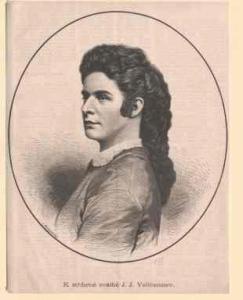
Elisabeth’s transformation. .
In the third decade of her life Elisabeth’s personality underwent a remarkable transformation: the emperor’s shy, childlike bride became a confident and strong-willed woman who was determined to shape her lifeon her own terms ‘Even though you were very cruel and vexing, I love you so boundlessly that I cannot be without you.’ Extract from a letter written by Franz Joseph to Elisabeth Source: Conte Corti, Egon Caesar: Elisabeth. Die seltsame Frau, Wien 1942, p. 163 After the first years of her marriage Elisabeth succumbed to a phase of resignation. Although she at first tried to fulfil the expectations that has been placed in her, she soon fell into a kind of passive resistance. The mysterious illness from which Elisabeth was reported to be suffering from 1859 can to some extent also be seen as her way of escaping the pressures that beset her. The young empress was able to ‘take a holiday’ from life at court and the domination of her mother-in-law in the form of extended stays at health spas. The nature of the relationship between the two women has been explored at length by biographers. The conflict was rooted in a completely different approach to the role of empress. The ambitious Sophie had deliberately foregone this position, sacrificing her personal happiness to the good of the dynasty. By contrast, Elisabeth had stumbled into the role, which was to remain alien to her for the rest of her life. Elisabeth spent the winter of 1860/61 on Madeira recuperating physically and mentally. Six months later she was deemed to have been cured but postponed her return for another month in order to make a cruise on the Mediterranean, after which Franz Joseph urged her to come home. Soon after her return she had a relapse, prompting a four-month stay on Corfu. Franz Joseph again urged her to return, above all for the children’s sake. To encourage her he allowed Gisela and Rudolf to be taken to Venice, where they were reunited with their mother again after this lengthy separation. When Elisabeth returned to Vienna in 1861 all at court were greatly surprised to see that she had turned into a self-confident young woman. She began to demand her own space, ensuring for example that she and her husband had separate bedrooms, which was an unusual arrangement for married couples at the Viennese court. Having been described as pretty but also shy and childlike when she married the emperor, the empress was now also developing into a great beauty. Franz Joseph’s love for his wife grew ever stronger, but his affection was not returned to the same degree by Elisabeth. Nonetheless, the relationship between the two was marked by great trust and respect. Elisabeth was also adept at using her husband’s idolization of her to her own advantage. Another turning point in Elisabeth’s attempts at achieving a degree of independence came in 1865 with her ultimatum to Franz Joseph concerning the upbringing of her son Rudolf. Elisabeth threatened to leave her husband if the rigorous military drill to which her son was being subjected and which was negatively affecting the child’s sensitive nature was not ended immediately. Her ultimatum accepted, she ensured that Rudolf received an upbringing and education based on liberal middle-class principles, which caused a sensation at the Viennese court. It was also during this time that Elisabeth’s only political ambitions came to the fore, in her fervid support for the project of the Compromise with Hungary that was eventually realized in 1866/67. Elisabeth was to retain an enthusiasm for the language and culture of Hungary all her life. She admired the Hungarians’ struggle for independence, and her lively interest in Hungarian affairs made her very popular there. She had an intimate friendship with the later Hungarian Prime Minister Gyula Andrássy which is often painted as a romantic relationship; however, this is regarded as highly unlikely. The birth of Elisabeth’s youngest daughter Marie Valerie, who was born in 1868, ten years after Rudolf, was connected with the empress’s enthusiasm for all things Hungarian. Known as the ‘Hungarian child’, Marie Valerie was brought up with Hungarian as her first language, dearly loved and idolized by Elisabeth. The empress was now able to live out her role as mother unopposed. Martin MutschlechnerFrom site : http://www.habsburger.net/en/chapter/elisabeths-transformation
Sisi: the Amazon, the sites of riding and horses
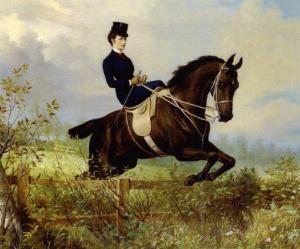
Accidents on horseback Empress.
This is 1875 - "Pays de Coux" - Sassetot - Normandy in this small town Sisi she used to spend the mornings and afternoons to swim the horses. The Countess Festetics had noticed how the English riding instructor Allen incited the Empress to perform stunts ever more reckless riding a new horse, Zouave. The result was a serious accident on September 11, after which the empress reported a mild concussion. The Empress Sissi resumed within a few days and we do not even think to curb his passionate activity. However, Maria Valeria had to promise never to use the mother horse was Sissi itself to instruct Allen to do an obstacle course in the grounds of Chateau de Sassetôt.Durante one of the workouts, Elizabeth's horse stumbled and she fell out of the saddle. In the fall, the Empress lost his hat and knocked his head hard against the ground, hardened by season calda.Immediatamente was sent a telegram to FG. The emperor wanted to go see her, but was strongly sconsiliato to do so, having regard to the relations between Austria and Francia.Pochi days later in a letter to Elizabeth FG split: "I am distressed to have you scared so much, but both you and I have prepared for these incidents ... I'd love to have other horses in Godollo. Here I've had so little to work well and are anxious to see that you have not sange but the cold with this fall "In March, 1876, Elizabeth made his first trip to England, staying in Easton Neston It was during that stay the Empress, after a few others, had Bay Middleton as a pilot. It is said that on their first day together on the field hunting she wore a blue dress with gold buttons. The resumption of hunting lasted 25 minutes during which both Elizabeth and Middleton rode their horses to perfection. Only at the end, the horse of Elizabeth failed to pass a ditch, remaining stuck. Middleton, vedenddo the dangerous situation, he was right with you: the "jerk" out of the saddle and helped her to her feet. Elizabeth did not hurt and was not even shaken by the incident. He thanked his Bay Leaning one hand on top of the pilot. When the horse was recovered, they realized that the horn of the saddle riding habit was broken. But this does not imporatava as Elizabeth - she got what she wanted for some time: a path exciting hunting in the Shires, full of obstacles and with a special pilot that would acomagnata in many other hunts. In 1879 took place the journey of Sissi in Ireland. The Empress lived in Summerhill. Despite great difficulties adattemaneto the Irish land and many of the members falls in the wake of the Empress, it seems that she was more fortunate than others. An episode that you remember is this: at the end of the stay Irish mare The Widow (Summerhill renamed in honor of your stay) slid on top of an embankment. Elizabeth reacted immediately jumping out of the saddle and letting the horse get up. Subsequently, Middleton helped her back on the bike and the hunt went on as if nothing happened. 1879 was also the year of the silver jubilee of the Imperial couple. Given the lack of interest for her husband and an unbridled passion for horses, the gossips coined the phrase "25 years of ménage but, Had Been 25 years horse-gear" (25 years of marriage, but handling) In 1879 he played the Sissi trip in Ireland.
Sisi.......the Empress wrong
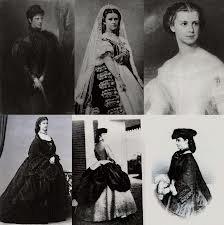
Sisi: The Empress wrong..........
Psychological profile of Sissi of Austria, unhappy queen who dreamed elsewhere by Alessia Ghisi Migliari
And 'no doubt that history has often had little children calm.Brilliant characters, sometimes even heroic, bring with them, in many cases, almost as a counter to such a dowry or fortune, emotional instability or minds complicated and difficult to read.So, without any claim clinic really is interesting you want to create, for once, not a biography in itself, but a psychological profile.Maybe that leaves more questions than answers, but that changes the point of view, and makes us curious to look a little more and a little more in the end.And with this intezione, name famous and charming, we get to Sissi, Empress of Austria, who did not know and wanted to be one.MOUNTAIN GIRL, WOMAN WITH THE CROWNThe story is well known, despite having been released from films and silly little true of Elizabeth sweet and lovable.Dynamic and lively daughter of Max, Duke in Bavaria (and that '"in" means that it is a humble junior branch), grows in the woods free, mobile, sports, tireless.And it is just a teenager when, going to visit his aunt, the Empress Sophia, the heir to the throne, Franz Joseph sees her and falls in love.In fact, Elizabeth was there as a companion of her elder sister Elena, poised and beautiful young man, who everyone thought would be the bride of your choice.But faced with the freshness and ingenuity of Sissi, lunghissi and his magnificent hair, informality of his ways (so different from the Habsburg tradition), the royal offspring and decides not intezione to reconsider.A fairy tale, at least initially.But the beautiful lady was sixteen poor, he finds his wife (which in itself would not be unusual for his time and his social class, were it not for the enormity of the role he was going to play) and future empress.The honors and charges are numerous, commitments and daily duties, like the richness and possibilities that are opened first.Knowing how to manage, his place is on the top of Europe and beyond.But too small, not so polite to the fore, not accustomed to the label, the result will be disastrous himself.Increasingly plagued by psychopathological symptoms - in short, it was terribly distressed and manifested with joints and bizarre behavior - became absent figure, who did not attend when he had to, he was away from his family and from his responsibilities, committed to travel, travel everywhere, forced movement, to the same physical activity that will become an outlet and means to pursue physical perfection.And always die abroad (at the hands of an anarchist), Switzerland, just 60 years old, in 1898.SEWN WITH CLOTHES ON YOUShe was tall and 1 meter 72.For most of his life weighed 50 pounds, but he managed to reach 46.His waist, even after the forty springs, was just 50 centimeters, which would disfigure also our models, as Sissi lived in an era that still liked women full and soft.But in the form of ascetic beauty, probably trying to create a body, light, free from the constraints of his daily life.The body as rejected, modeled escape.Ate very little, mostly dairy products, sometimes, his lunch was just a bit of sauce.Yet, he spent much of the day to exercise, to "download the nerves" and stay toned.He rode for hours (you said it was one of the best riders in Europe), covering such a long way to pulping horses.It gave the fencing, to walking and climbing in the mountains, in each house was to install a gym, attending obsessively.To emphasize its enviable line, and confirm his reputation as a beautiful (although beyond the canons), he ordered the clothes on the ropes, and it took three hours to get daily combing the magnificent blond hair brown, almost came to ground and had to be flawless.They had to.Its inability to maintain control of a life controlled by others (the mother-in-law, the rules, the children raised unknown), vented his frustration total intransigence towards their appearance.It was a mortifying and celebrate together.And even if there is no evidence that rimettesse after eating, these characteristics make it quite truthful leleggende current of her anorexia.According to the DMS IV-TR (Diagnostic and Statistical Manual of Mental Disorders, latest edition, reference text for psychodiagnosis), one of the possible forms of anorexia nervosa is the "subtype with restrictions", in which the weight loss is not achieved by binge / elimination, but with dieting, fasting and intense physical activity.His body mass index (BMI), so often quoted today for the reference numbers, came to be 16, and would have to be at least 19 (about ten pounds heavier).No one could keep up with her.Then, however, took place obvious periods of fatigue, extreme weakness, respiratory physical symptoms are not well defined (the more times you thought was going to die), but that disappeared when he is far from Vienna.ELSEWHEREMadeira, Corfu, anywhere.Draw a map of his physical movements durantela continue his life as a wife of Francis Joseph is not feasible.It 'a come and go delusional.Arriva, calms the anxiety comes back again.At least, that is not evil: his lungs do not suffer, she is not without energy in bed, next to Al beyond ... so, no one but no one approves ban.I do not mind, no. At least with a conscience.Only projects on his body, the discomfort of being in Vienna, that sense of 'oppression', to be "a bird in a cage", a "seagull" without freedom (many poems she wrote when he returned on the subject).The physical location becomes controlled by her expression of pain, a sense of suffocation that the abandoning even when, in fact, no one was holding, as he criticized his behavior.He could not go down narrow stairs, had panic attacks (sweating, increased heart palpitations, he felt he was dying, he had to escape, the air was missing and his head became light, with a sense of unreality), and only when he was in his native Bavaria, the situation calmed down and she came back enthusiastic girl.Throughout the rest of the time, hyperactivity was futile attempt to escape their fears, their own sense of inadequacy, a challenging part that risuciva just acting.As she admitted: "After all I always desire to continue their journey. When I see a ship sail, I regret that I am not on board. No matter who is headed to Brazil, Africa or Cape Town. Just do not stand still for a long time in the same place. "THE SEAGULLSometimes the precise diagnoses are not so important, and the outlines of a disorder and the other fade.Anxiety, depression, anorexia, hypochondria, phobias, panic attacks, hyperactivity disorder (although not a girl) said ... so it looks like Sissi did not escape.But they are all faces of the same coin.A young woman, mother and empress, not grown for this role.Not that he wants to make a victim, for heaven's sake: the victims have nothing to do, she was undoubtedly a human being privileged.But not everyone has the strength to live privileges.And she grew up of woods and rivers, locked in political obligations and the label, came to show the raw and unpleasant aspects of his character.In revolt against the "System", intolerant of the witty but not dear and loving husband, his anger and his rudeness could not be counted.As he wrote to his cousin Ludwig II (very mentally ill), with whom he shared a close relationship of romantic ideals, she was a seagull.And a seagull may not close in cold rooms, as magnificent and important.After the death by suicide of his son and heir Rodoldo, many symptoms went esecerbandosi.Fearing that he would old scratched his perfection designed to reassure the swirl of movement in recent years meant that it was never pressecchè in the Austrian capital.In the end, what remains is an unhappiness that had a definite guilt and condemnation.That he had had the gift of a huge place in history.And, as often happens, few are able to deal with such glory.Elizabeth, intelligent and strong-willed, was not born to be empress.However it became.It was never herself.
From: http://www.instoria.it/home/imperatrice_sbagliata_sissi.htm
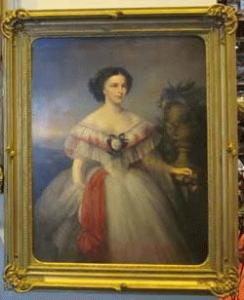
Profile of Empress Elisabeth of Bavaria.
Probably no Hapsburg consort has been so celebrated or so lastingly famous as Elisabeth of Bavaria, the legendary beauty best known to all as “Sissi”. Over time, the Empress has become iconic, mostly as a tragic figure. However, while tragedy is certainly far from unknown in royal history, and that of the House of Wittelsbach or Hapsburg particularly, in the case of Sissi, I think the “tragedy” of her life has been somewhat exaggerated and, to some extent, much of her sorrow appears self-inflicted. Yet, there is no denying that there was, and still is, just “something” about her that has fascinated people all over the world for over a century. Even as a historical figure she commands attention. Whether or not she deserves our sympathy is a more complicated, and probably controversial, question.A Christmas Eve baby, Sissi was born Elisabeth Amalie Eugenie, Duchess in Bavaria, on December 24, 1837 in Munich to the music loving (and somewhat morbid) Duke Maximilian Joseph in Bavaria and Princess Ludovika of Bavaria. She grew up in Possenhofen Castle, the fourth of ten children, and a pretty normal upbringing, perhaps a bit on the liberal side, for a young girl of minor Bavarian royalty. Her father impressed upon her a love for the circus and a genuine concern for the common people. She liked taking long walks and loved horses but was not a particularly attentive student. Sissi was not considered extraordinarily gifted nor, interestingly enough for someone who became such a famous beauty, was she considered especially attractive as a child. She liked the zither, liked looking at things from alternate points of view and she was terribly shy around strangers; all qualities she would never completely lose.Contrary to what some think it was actually Princess Ludovika (rather than Princess Sophie) who was most interested in pushing another Hapsburg-Wittelsbach marriage. In 1853 Princess Elisabeth and her older sister Helene were taken by their mother on a little vacation to Upper Austria where the Duchess Helene was to be aimed at the young Austrian Emperor Francis Joseph. Yet, it was the 15-year old Duchess Elisabeth, a luminescent beauty to be sure, who captivated the Emperor and he determined to marry her. His mother, Princess Sophie, advised against it, fearing that Elisabeth was too immature, but Francis Joseph would not be dissuaded and on April 24, 1854 he and Elisabeth were married in Vienna. From that point on she became Empress of Austria. The strict protocol of the Hapsburg court was quite a change from the relaxed, informal life she had lived in Bavaria and there was a clash, from the very beginning, with her new mother-in-law Princess Sophie (or Archduchess Sophie). She had not been overjoyed with Sissi as a wife for her son, thinking her too young and immature and, from the start, Sissi did not do much to prove her wrong.As Archduchess Sophie set out to make Sissi her own special project, to train her for the “job” of Empress, Sissi snubbed her and did not take kindly to instruction. Whenever there was a problem Sissi would rush to Francis Joseph to take her side, which he tried not to do, and thus the man with the cares of an empire on his shoulders was often caught in the middle of squabbles between the two most important women in his life. Sissi became rather offended when the Emperor did not always take her side, however, Francis Joseph has always been brought up to be a loyal son and, in a very real way, he owed his throne to his mother who had persuaded her own husband to abdicate his rights to the throne so that the Hapsburg crown could be passed directly from the Emperor Ferdinand I to Francis Joseph. Many at court, and Archduchess Sophie certainly among them, were also alarmed that Sissi seemed to have more sympathy with the people they saw as the enemies of the monarchy than she did for the House of Hapsburg itself. One area which became something of a sore point was her fascination with Hungary.Many in Vienna were still haunted by memories of the failed Hungarian Revolution of 1848 when rebel leaders declared a republic and nearly brought down the whole of the Hapsburg empire. Because of this, there were many who remained very nervous about any and all things Hungarian. Empress Sissi, however, was enthralled by Hungary, loved the people and at great effort learned the history of the nation and to speak Hungarian (which was not easy as it is a very unique language). There was, of course, nothing wrong with this, she was the Queen of Hungary and it was completely proper for her to take an interest in the country. In return the Hungarians adored her and Sissi came to be seen by the Hungarians as their highest advocate in Vienna, which she was. Yet, others in the German-speaking half of the empire were put off by her sudden fascination with all things Hungarian and tended to see it as a slight against the Austrians, as if Sissi was siding against them in being so sympathetic toward Hungary.All of this made Archduchess Sophie even more worried that Sissi did not have the best interests of the House of Hapsburg at heart. She feared this interest came about for the wrong reasons and could be taken advantage of. On that count she may have been correct as there were some anti-Hapsburg republicans among the network of those affiliated to varying degrees with the Empress. In any event, family matters continued on and in 1855 Sissi gave birth to her first child, Sophie, who was named by her grandmother after herself without the Empress having anything to say about it. The following year Archduchess Gisela was born and Sophie largely took charge of them both, not really trusting her daughter-in-law to raise them properly. This was unfair but Sissi did herself no favors by constantly persisting in doing exactly the things that would make people uncomfortable about her. She was constantly at odds with Sophie over the children and became increasingly depressed about her life. Of course, she wanted for nothing, lived in lavish surrounding, had a devoted husband and so on, yet she seemed to have made up her mind to be unhappy and nothing could change it.The first great tragedy of her life came when, to her delight, Emperor Francis Joseph decided to undertake a state visit to Hungary in 1857 in order to foster better relations and Austro-Hungarian goodwill. He of course would take his Empress along with him, regarding her as his most valuable asset on such a mission given how beloved she was in Hungary and counting on her ability to charm the Hungarian nobles. Sissi was thrilled with the idea but ran afoul of Sophie again when she insisted on taking the children along. The girls had been sick with diarrhea and their grandmother insisted that they stay behind with her so she could take care of them. The doctors agreed that it would be unwise to take them on such a trip but Sissi would not hear of it. If the children could not go, she would not go. Emperor Francis Joseph could hardly make the trip without her, she was the most beloved member of the Imperial-Royal Family in Hungary and most cared far more about seeing her than they did their king. So, for a change, Francis Joseph took the side of his wife and let her bring the children along. However, as the doctors had predicted, the girls became even more ill. Archduchess Gisela managed to recover but the little Archduchess Sophie did not.There was immense sadness and some anger over the death of the little archduchess. Sophie took it as proof that Sissi was an unfit mother. The Empress was devastated of course and the situation was not helped by the attitude taken by many who has been against her all along that the tragedy confirmed their view that Sissi was headstrong and immature, more concerned with having her own way rather than what was best for the family. The fact that the court doctors had urged against the children making the trip only made things look worse and even Emperor Francis Joseph was never quite the same toward his wife as he had been. For Sissi, her depression deepened, not much relieved with the birth of an heir to the throne, the Crown Prince Rudolf, in 1858. Needless to say, Sophie took charge of the baby boy at the outset and Sissi never had much to say about his upbringing. Sissi made herself sick and finally had to leave Vienna for lengthy periods of time, only returning when she feared that the military training young Rudolf was going through would hurt him. Sissi went to the Emperor and threatened to leave him if she was not given complete control over the upbringing of their children and Francis Joseph had little choice but to agree. Yet, after this, she took very little interest in her son which caused many to think, again, that this was a matter of Sissi having her own way rather than a genuine interest in the upbringing of the Crown Prince.In 1867, with restlessness still strong in Hungary, Empress Sissi was key in working out the compromise, agreed to by her husband, which put aside the Austrian Empire and created Austria-Hungary. This was the one political issue she was instrumental in, due to her love of Hungary and her great popularity amongst the Hungarians. From that time on the Hapsburg empire would be one monarchy reigning over two countries, separate but equal, each with their governments and each with their own legal systems. Franz Joseph and Sissi reunited to go to Budapest for their formal coronation as King and Queen of Hungary. In 1868, in Hungary, Sissi gave birth to her last child, Archduchess Marie Valerie, who she had all to herself from day one and who she always favored best.By that time, Sissi had become famous all across Europe for her beauty and, may have been the first “royal celebrity”. People eagerly read anything about her, trying to follow her example in fashion, diet, exercise and anything else. Anything Sissi did instantly became fashionable. With all of this attention, though always a very shy person, Sissi became obsessively vain, determined to remain on the pedestal the public had placed her on. She went to extreme lengths to maintain her youthful, beautiful appearance such as bathing in olive oil or starving herself. This was of less interest to the Emperor than her increasingly vocal liberalism, witty criticism of the Hapsburg monarchy or the radicals, even republicans, she often associated with. She became increasingly pessimistic regarding the survival of the Dual-Monarchy. Still, there was little to be done as the Empress was often traveling abroad and only rarely visited her husband in Vienna. Nonetheless, she was deeply disturbed when she learned of the death of Crown Prince Rudolf, allegedly at his own hand, and it was she who was the first to know and who had the unfortunate duty of breaking the news to the Emperor and the mother of her son’s mistress who died with him.Sissi did not take the loss well. First, in quite a cruel display, she blamed Rudolf’s wife Princess Stephanie of Belgium. Given the problems she had with her own mother-in-law, it may surprise some how cold Sissi had always been toward Stephanie, dismissing her as altogether too pious and unattractive (as a woman who was rather obsessed with her own attractiveness) and she accused Stephanie of driving her husband away by being unaffectionate and aloof. Likewise, for a woman who held such liberal views and who was generally disdainful of monarchy she had always considered the Belgian Royal Family too lowly to be tied by marriage to the venerable House of Hapsburg. All of this was quite unfair to Princess Stephanie who had given the Crown Prince a daughter and might have given him a son were it not for the fact that Rudolf gave her a venereal disease, picked up during his frequent carousing, that made her infertile. Later, however, Sissi began to blame herself or more particularly the history of insanity in the Bavarian Royal Family and she began to fear that her blood had caused Rudolf to take his own life.The Empress withdrew even further and wore mourning for the rest of her life, though she remained the most famous royal figure of her time. Her behavior became increasingly erratic and self-destructive, traveling compulsively and dieting to the point of near starvation. She rarely saw her husband and was seldom even in Austria-Hungary. Her seemingly endless travels around the Mediterranean finally did come to an end, in another one of her favorite places to visit; Switzerland. She happened to be walking along the shores of Lake Geneva at the same time as an Italian anarchist named Luigi Lucheni. For no other reason than that she bore the title of “Empress” the anarchist attacked Sissi with a knife, stabbing her in the heart on September 10, 1898. It was a sudden and violent end for a woman who seemed to have been unhappy for most of her life, even if few could understand exactly why. In all the years since her fame and attraction have not diminished as she has been featured in countless books, plays, ballets, television shows and movies. Few other consorts have ever been or remain so famous, particularly considering how little time she actually spent at court or with her husband.To this day, the Empress known to everyone as Sissi, continues to hold a special place in the hearts of many. Personally, I cannot count myself among her many admirers, yet she remains an undeniably attractive figure. Although I can understand the fascination with her life, I cannot have a great deal of sympathy for her. Being a royal, and a royal consort for certain, requires a certain selflessness and devotion to duty which, it seems to me, Sissi simply did not possess. Taking all I know of her story, the impression I am left with (forgive me Sissi fans) is that of a basically self-centered woman, concerned more with her own feelings and her own image than the welfare of her family, country or dynasty. Her marriage seems ill-fated indeed considering that duty and obligation were the constant principles for her husband. I regret that she was to such a large extent an unhappy woman, yet, it seems to me that she simply made up her mind to be unhappy and that was that, despite having what most people would consider more than enough to make a happy life. In any event, I hope she has found peace, where she is now.
From site : http://madmonarchist.blogspot.it/2011/08/consort-profile-empress-elisabeth-of.html

The last official apparence f Elisabeth.
the June 8, 1896Elisabeth shows for the last time at the solemn reception of the HungarianParliament. The most important newspaper in Budapest "Pisti Hirlap,"reports the ceremony: "Here it is, allin black, in the throne room at the Royal Castle, wearing the Hungariancostume, ornamented with lace, is the image of pain .Un black veil descendsfrom his dark hair; pins blacks, black pearls, and everything in this black, awhite face like marble, a infinite sadness The Mater Dolorosa (............). The beautiful face ravaged by painhas retained its nobility. It 'the same framework but as veiled in a mist(.............) It’s pale, motionless. At this point the speaker appoints theQueen, who does not move, but suddenly hear a "ejen "as in the castleof Oten had never heard. Looks like a storm of feelings that rises from allhearts. And it emanates an accent sublime, wonderful, ineffable. This"ejen "passes a prayer, a sound bell, the roar of the waves, tenderness andalso it seems, a bouquet of flowers. And then the majestic face, hithertoinsensible, is animated. Slowly, almost imperceptibly, she bows in gratitudeand that his gesture has a infinite grace . Resounds a "ejen" louder,ever renewed, that shakes the lintels. The great nation ofwielding their bearskin. l '"ejen" continues incessantly, requiresthe silence speaker and Queen bows his head. His pale face begins to color.Gradually assume the color of fresh milk from a faded pink reflection, then turnsred, the red of the life.I his eyes open and shine of their former glory. Thoseeyes that knew a time smile with such seduction, which comforted a miserablecountry, now fill with tears. The contact is re-established. A happy countryhas been able to comfort the queen, butonly for a moment. The queen moves lace handkerchief to her eyes, wipes her tears and the speaker continues. Gradually thecolor of life shrinks from the face of the Queen, and soon, next to the King, sheresumed her place the Mater Dolorosa
From the book"Sissi - Life and Legend of an Empress" by Nicole Avril
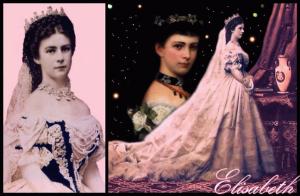
Elisabetta Amalia Eugenia, Duchess in Bavaria, daughter of Duke Maximilian and Princess Maria Ludovica, born December 24, 1837. He lived a serene childhood in Bavaria, the castle of Possenhofen, on the shores of Lake Starnberg, without complying with the 'label that was in force for the noble families and in complete freedom. Nell 'summer of 1853, all' age of fifteen, he went to Bad Ischl on the occasion of the engagement of Helen, his sister, bride of 'Emperor' Austria, Franz Joseph I, who was then twenty-three years. Francis Joseph, however, fell in love with Sissi - as he was affectionately known - at first sight. It hit its simplicity and spontaneity. The night he would get engaged to Helen, Francis Joseph asked, behind the amazement of those present, the hand of Sissi and April 24, 1854, the 'Emperor in Bavaria and Princess Elizabeth were married in Vienna, in the church of the Augustinians.
Since the early days was brought up by Sissi 'Archduchess Sophia, mother of Francis Joseph, the rigid Spanish court ceremonial which reigned at the Hofburg, the imperial residence in Vienna that Elizabeth called a "gilded cage". Franz Joseph began work each day at five in the morning and Sissi could see him very rarely, so that it became increasingly sad, melancholy and nostalgia, the carefree days he had spent Possehofen. His marriage to the emperor were born four children: Sophia, who died just two years, Gisella, Rodolfo and Maria Valeria. The fears of Sissi increased with the passage of time and urged her to write many poems full of regret dedicated to Bavaria.
In 1859, Elizabeth left the emperor moved to Madeira and Corfu ', thus beginning a series of trips that took her to visit most of Europe. After being crowned Queen of Hungary, he retired permanently to private life, devoting himself exclusively to his interests, such as horseback riding and poetry (with a particular fondness for Heinrich Heine) and taking lessons from the greek young teacher Constantin Christomanos, that the followed her everywhere. He spent many hours caring for her beauty: she was very proud of his hair, which reached to the calves. Every morning when I woke up, he plunged into a tub of ice water, after which her hairdresser, Fanny Angerer, spent about three hours to acconciarle and brushing her hair, because of their heaviness, they caused to 'Empress continuous migraines. The Empress liked to take long walks and walked so fast that his companions had serious difficulties to follow. The 'only one who could do it was Francis Joseph.
Although it was the first woman of a great empire, his life took many dramatic moments: the death of his first daughter, Sophia, and the death of his cousin Ludwig II of Bavaria, the assassination of Maximilian, brother of Francis Joseph, who became king of Mexico and killed by the revolutionaries, the suicide of Rodolfo, the only son of Elizabeth, happened at Mayerling January 30, 1889, and finally the death of his sister Sophie, Duchess of Alençon, in a department store in Paris in 1896. Sissi began so always dress in black, always trying to isolate themselves from others and spent the last years of his life away from her husband and the Viennese court. On 10 September 1898 in Geneva, the anarchist Luigi Luccheni, after learning that the Empress was staying incognito at the Hotel Beau Rivage, pierced her heart with a dagger: after just seven minutes, Elizabeth died, and his legend was born.
From site: http://www.ladyreading.net/sissi/biografia.html
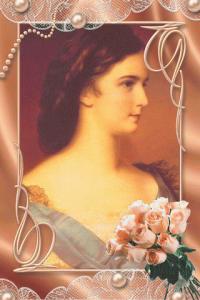

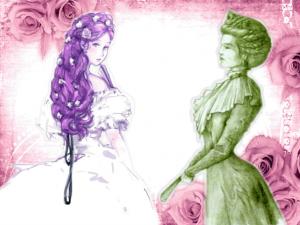
Anecdotes
Month after month, Elizabeth becomes more 'subtle, more' slender, more 'high. From Possenhofen, Franz wrote to his mother: "Every passing day I love more Sissi 'deep and are increasingly convinced that no woman could myself more' suitable '. To stop any objection even adds: "Now his teeth are very white, and this' thanks to your recommendations." White lie! In reality 'as it may conceal Elizabeth' his teeth, the criticism of 'Archduchess have already' made to disappear for half 'her smile.
(Nicole Avril)
All 'foreign country' s popularity is growing from Elizabeth, but the court is always something to criticize in his behavior or his person. In fact, the countesses envy her beauty. And not only 'made bitter by' Emperor, sottrendo them more 'nice party' s Europe, but also seduced the people of 'empire, even those more' rebels. With the complicity 'of active' begin to envy the Archduchess revenge. They decide to organize a beauty contest in court, a sort of "Miss Schonbrunn." Unlike in the current competition, you do not ask those who are vying to run. Soon the jury, after several secret meetings, announces the result and was elected "Beauty of the court" Maximilian's girlfriend, Charlotte of Saxe-Coburg. The gesture, inelegant and unfair, right on target, has the result that two cognate enemy and inflicts a wound to Elizabeth further. Was said to be incomparable. Well, and 'dared' s Empress competes with other beauties, and by this test and 'output loss.
(Nicole Avril)
Elizabeth and her younger sister Maria would meet at night, barefoot on the carpet of the Hofburg. As two of school, smoked secretly screwing up the 'high window to be betrayed by' smell of cigarettes.
(Nicole Avril)
When doctors advise them to go to cure your cough in a sunny country, Grasps the 'occasion. The warm temperature, the journey, the sea. Love what it 'loneliness, needs an' island. Franz Joseph proposes the 'Adriatic,' yet the 'Empire. Will be able to 'go and see her, be happy again, everything will be back' as before. But Elizabeth refuses the 'Empire, rejects the' Emperor. He wants his island is unreachable. It chooses Madeira.
(Nicole Avril)
The German painter Franz Winterhalter, whose brush enjoys the favors of the sovereign, he was invited to Vienna. Uffiale paints the portrait of Elizabeth as queen of the fairies. Her hair, her white gauze dress is sprinkled with stars. Fully at ease in his role as romantic, it is shown smiling and sad. The painter will paint 'two other portraits of her lesser-known, in which she prevails on' Empress. In the first, one of her white shoulders emerging from a disorder of lace. As for the hair falls in curls and dark auburn to below the hips, and you can not 'agree that Rudolph for preferring this to any other carpet. Once finished, the portrait and 'jealously requirement from' Emperor which puts him in the study of the Hofburg, where he spends most of his time. "Finally a portrait that truly looks like," says the 'man in love. In the second of these intimate portraits Elizabeth wears a kind of fluffy dressing gown. Her hair is tangled and knotted on the breast.
(Nicole Avril)
This 'that most' liked Elizabeth at Lainz villa - the "Titania's enchanted castle," as he called it - was a lonely position, the center of a series of intact forests, populated by many deer. The Lainz Tiergarten was surrounded by a wall. The gates were manned by guards. No outsider pote 'see the villa until' Elizabeth was alive. The 'Empress could walk for hours, watching the game, or compose poems.
(Brigitte Hamann)
The poems of Elizabeth, all written in the 80s (after the death of Rudolf, in 1889, Sissi process 'all' sudden composing poems), spanning a total of about six hundred pages in print. The entire collection and 'one great hymn dedicated to the much loved and respected "teacher", Heinrich Heine. This admiration far exceeded the 'usual love of a lover of literature. Elizabeth knew by heart many and long passages of Heine and became interested in 'to the life of the poet. He believed in the 'existence of a close bond between her and the bard died in Paris in 1856, is considered to be his disciple and even said that his verses were dedicated by the master himself. "Every word, every letter, everything 'that comes from Heine, and' a jewel," Elizabeth wrote to her daughter Valeria, confessing that the poet 'and' always and everywhere with me. " [...] Elizabeth's reputation as an expert in Heine was so widespread that sometimes it was even consulted by scholars, such as, for example, a student of literary history in Berlin. These introduce the 'three unpublished poems of Heine and pray' to express an opinion, to tell him, that 'if the verses, very sensitive content, should be published or not. Elizabeth replied with a long autograph letter, I declare 'that one of the three poems was not authentic (and he was right, as was demonstrated by a subsequent investigation) and the Board' the publication of two other poems.
(Brigitte Hamann)
L 'former Queen Maria of Naples was also the "star" of the' Album of beautiful women who begin Sissi 'to put together in Venice in 1862. [...] When it was a beautiful woman, Sissi - as Uncle Louis - did not care of the 'existence of an aristocratic family tree free from blemishes. Like Louis, she inserted in their book Women of all classes, even women who do not know at all.
(Brigitte Hamann)
The growing fame of the extraordinary beauty of Sissi became a burden more and more 'heavy' s time to go. [...] The clothes she wore, the jewels, the 'hair: all these details were discussed in depth by the people. Any, even the slightest error in 'clothing, any mole that could detract from the beauty, was noticed and commented. At any time Elizabeth had to prove that the woman more 'good of the monarchy.
(Brigitte Hamann)
Elizabeth was now over fifty. No more 'he was portrayed, it' a painter, it 'by a photographer. No more 'went' around with no fan or no shade, which hid the thin face, furrowed with wrinkles and hardened by the weather. The black fan and 'white parasol became, as he wrote Christomanos, the reader greek Elizabeth, "the faithful companions of his external existence," indeed, "most of the components of its appearance."
(Brigitte Hamann)
Once during the last years of his life, the 'Empress appeared in public, performing a task of representation: it was in 1896, during the millennial celebration of Hungarian. He was so changed that few recognized it: "A black woman's head, a new face, unknown, sad, whose smile produced the 'effect of a pale reflection. Greet with grace, but in an almost mechanical. This face is different , so to speak, from all the others, "wrote the Hungarian newspaper" Magyar Harlap. " As usual, here Elizabeth continued 'to hide your face with a black fan.
(Brigitte Hamann)
Now the embalmed body of the woman and that 'was the radiant and painful Sissi, lie in the coffin. The restless traveler has found its final port and his first rest. The 'have covered most of his' beautiful black dress, her magnificent hair was combed like when he was alive. The face has regained all his youth ', in the paleness of wax. On the table of the room were propped her jewelry more 'loved ones, his family memories: the' ring that she wore hung around his neck on a chain of 'gold, its range of leather, his English watch kept in a casing in shaped bracket, his bracelet full of charms devotees, the sun sign to three feet, the locket containing the hair of Rudolph, the skull. All symbols are ', bearers of memories. The drama and 'was played out, the curtain' fell.
(Elisabeth Burnat)
From site : http://www.ladyreading.net/sissi/aneddoti.html




